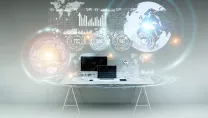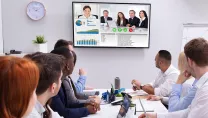The COVID-19 pandemic changed the perceptions on work and what it means to ‘go to the office’. Now, as workspaces open back up, Rob Davis Solutions & Services Business Manager at Sharp, looks at how workers’ views and expectations on where and how they want to work have changed.
As the office once again becomes a viable and safe option, many businesses are experimenting with different working models, from fully remote, back to the office, and especially hybrid working. But the question on many business leaders’ minds remains: ‘which technique is right?’
Each business leader has his own opinion, and every business has a different need and requirement, but new research from Sharp in The Future of Work, exploring the opinions and perceptions of 6,000 office workers in SMBs across Europe, is revealing insight into how workers’ views and expectations on where and how they want to work have changed.
How the Pandemic has Altered Employee Work Perceptions
Despite the numerous benefits of remote work, including reduced commuting, the flexibility of living location and freedom to balance work tasks with personal life, Sharp’s study revealed there is still a significant appetite among younger and older workers to return to the office. 56% of those surveyed said that the ability to meet with colleagues physically has become more important to them since the pandemic, while 34% believe each age group can readily learn something from one another in the workplace.
In addition, onboarding younger staff in a fully remote environment can prove difficult for managers and overwhelming for the employees themselves. Without interacting, networking, and navigating office politics, it becomes difficult for new employees to fully connect. 61% of younger workers agree it’s hard to stay informed on what’s going on in the company when working remotely and 55% agree they feel ‘cut off’ from their team and work longer hours when working remotely.
One point that all workers agree on is the ability to balance working in the office and working remotely; with a hybrid approach ranking higher than either full time remote or full-time office working in every country. This means that the key requirement for both the younger and older workers is flexibility. 47% of 38-45-year-olds think their employers should offer flexible hours, Future of Work psychologist Viola Kraus points out in our Future of Work report, and that younger generations accept flexible working options as a given; they simply won’t work for a company that doesn’t offer it.
How the Pandemic has Altered Employee Expectations for the Office
There is still a clear demand to get back to the workplace as the office is the heart and soul of a company. A space that fosters creativity, productivity and positivity that reflects the organisation’s brand and culture. However, the reality is that many workspaces need reimagining and redesigning to meet the collaborative and interactive expectations post-pandemic employees are now looking for.
One of the biggest concerns for employees is the lack of suitable technology in the office. Not only do staff expect state-of-art hardware and software in the workplace, but they also require seamless integration between remote work and in-office technology. Essentially, the line between at home and in the workplace should be blurred.
Research also found that another main deterrent for employees is shared office facilities. Multiple companies occupying the same office space can often result in distractions, a lack of customisation to suit different company’s specific needs and most importantly, a dilution of an organisation’s culture and values.
Another major aspect that workers feel will deter them from returning is a restricted office layout. The days of working 9-5 at a desk are evidently behind us and the office structure should reflect this change. Employees are returning to the office for collaboration and interaction purposes, and a significant portion of the office should be devoted to this. This goal can be achieved through multiple techniques such as flexible desk arrangements and easy access to portable technology.
Companies looking to attract the highest calibre of talent and encourage a return to the office must perform a total agile transformation. Employees need a variety of working and meeting spaces. This includes everything from video conferencing meeting rooms and designated creative areas to social break-out and informal socialising areas. Adaptable furniture, moveable privacy screens, lightweight seats, and technology such as interactive displays, which allows employees to work together on one screen, can quickly transform a rigid office into a flexible collaboration hub.
How to Bridge the Office and Remote-Work Gap With Technology
To remedy these issues, Sharp has developed a variety of tools and solutions to ensure that employees' time in the office is as productive and impactful as possible. Devices such as the Windows collaboration display, which interacts seamlessly with the best Microsoft collaboration tools, can help to recreate a modern version of the ‘water cooler moment allowing multiple employees to collaborate on one display.
Sharp Dynabook laptops are designed with hybrid work in mind. Engineered with high quality, reliability, and easy mobility, they are the perfect laptop to easily transition from home to office work. Sharp’s office printers provide a simple way to create, engage with and share information. Using new-age software, they can top-up toner, refill paper, encrypt information and even carry out a full audit trail. This allows your employees to focus on more meaningful tasks, creating a more enjoyable experience in the office.
As employees continue to return to the office, companies need to use this pivotal moment to break old, pre-pandemic habits. An employee-centric and technology-led strategy can rejuvenate the workplace into a safe, collaborative environment that allows employees to enjoy their tasks and companies to achieve their goals.
If you would like to know more about hybrid working, or the tools and solutions mentioned above from Sharp, please Get in Touch.





